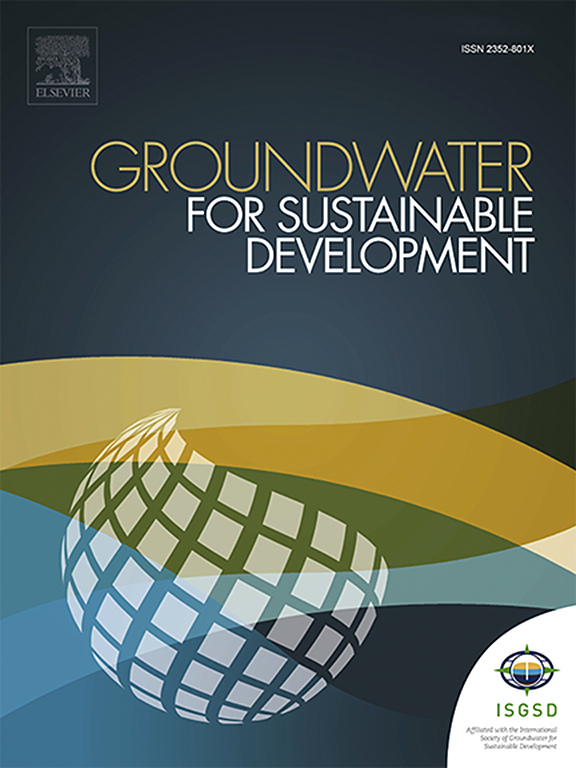孟加拉国干旱易发地区地下水的水文地球化学、水质和潜在人类健康风险评估
IF 4.9
Q2 ENGINEERING, ENVIRONMENTAL
引用次数: 0
摘要
日益严重的水污染问题对发展中国家、工业化地区和农业地区构成了日益严重的威胁,危及环境、人类健康和经济发展。因此,了解补给机制、水文地球化学、水质和地下水风险评估对有效的水资源管理至关重要。对45个水样进行了同位素和化学成分分析,以评价补给来源和适宜性。研究区分为新恒河漫滩(YGF)、老Mahananda漫滩(OMF)和更新世Barind平原(BT),其含水层厚度、地下地质和补给动态均不均匀。阳离子浓度顺序为Ca2+>;Na+>Mg2+>K+,阴离子优势为HCO3 - >;Cl−祝辞SO42−祝辞3号−祝辞NO2−。大多数参数在标准范围内,其中浓度升高归因于自然过程(例如,硅酸盐风化、阳离子交换和碳酸盐溶解)和人为来源(例如,肥料使用和污水泄漏)。同位素分析显示YGF含水层有活跃的降雨补给,而BT显示近期没有降雨补给,可能是由于存在一层厚厚的不透水粘土层。另一方面,OMF既有近期补给水,也有滞水,反映了含水层特征的空间异质性。Piper和Chadha图将地下水划分为Ca2+ - mg2 + - hco3 -型,表明暂时硬度。水文地球化学主要受离子交换、岩石-水相互作用以及方解石和白云石溶蚀作用的影响。熵水质指数(EWQI)显示BT区水质良好,YGF区水质不适宜,OMF区水质由好到差。非致癌性健康风险评估显示,砷是风险最高的,其次是NO2 -、NO3 -、Mn和Fe,儿童面临的风险高于其他组。在儿童和女性样本中,超过非致癌风险限值的比例分别为53.33%和33.33%。为了减轻这些风险,战略应侧重于改进农业实践、减少化肥施用、改进灌溉方法和提高公众认识运动。这项研究为查派纳瓦甘杰的地下水状况提供了宝贵的见解,有助于可持续水资源管理和保护公众健康。本文章由计算机程序翻译,如有差异,请以英文原文为准。

Hydrogeochemistry, water quality, and potential human health risk assessment of groundwater in a drought-prone area, Bangladesh
The intensifying issue of water contamination poses a growing threat in developing, industrialized, and agricultural regions, endangering the environment, human health, and economic development. Therefore, understanding the recharge mechanisms, hydrogeochemistry, water quality, and groundwater risk assessment is crucial for effective water resource management. Forty-five water samples were analyzed for their isotopic and chemical compositions to evaluate the sources of recharge and suitability. The study area is divided into the Younger Ganges Floodplain (YGF), Older Mahananda Floodplain (OMF), and Pleistocene Barind Tract (BT), which exhibit heterogeneous aquifer thicknesses, subsurface geology, and varying recharge dynamics. Cation concentrations followed the order of Ca2+>Na+>Mg2+>K+, while the dominant anions were HCO3− > Cl− > SO42− > NO3− > NO2−. Most parameters were within standard limits, where elevated concentrations were attributed to natural processes (e.g., silicate weathering, cation exchange, and carbonate dissolution) and anthropogenic sources (e.g., fertilizer use and sewage leakage). Isotopic analysis revealed active rainfall recharge in the YGF aquifer, while the BT demonstrated no recent recharge, likely due to the presence of a thick, impermeable clay layer. The OMF, on the other hand, exhibited both recently recharged and stagnant water, reflecting spatial heterogeneity in aquifer characteristics. Piper and Chadha diagrams classified the groundwater as Ca2+–Mg2+–HCO3- type, indicating temporary hardness. Hydrogeochemistry was predominantly influenced by ion exchange, rock-water interactions, and the dissolution of calcite and dolomite. The Entropy Water Quality Index (EWQI) values revealed good water quality in BT, unsuitability in YGF, and good to poor quality in OMF. Non-carcinogenic health risk assessments revealed arsenic as the highest risk, followed by NO2−, NO3−, Mn, and Fe, with children facing greater exposure than other groups. Non-carcinogenic risk limits were exceeded in 53.33 % of samples for both children and females and in 33.33 % for males. To mitigate these risks, strategies should focus on improved agricultural practices, reduced fertilizer application, modified irrigation methods, and public awareness campaigns. This study provides valuable insights into groundwater conditions in Chapai Nawabganj, contributing to sustainable water resource management and the protection of public health.
求助全文
通过发布文献求助,成功后即可免费获取论文全文。
去求助
来源期刊

Groundwater for Sustainable Development
Social Sciences-Geography, Planning and Development
CiteScore
11.50
自引率
10.20%
发文量
152
期刊介绍:
Groundwater for Sustainable Development is directed to different stakeholders and professionals, including government and non-governmental organizations, international funding agencies, universities, public water institutions, public health and other public/private sector professionals, and other relevant institutions. It is aimed at professionals, academics and students in the fields of disciplines such as: groundwater and its connection to surface hydrology and environment, soil sciences, engineering, ecology, microbiology, atmospheric sciences, analytical chemistry, hydro-engineering, water technology, environmental ethics, economics, public health, policy, as well as social sciences, legal disciplines, or any other area connected with water issues. The objectives of this journal are to facilitate: • The improvement of effective and sustainable management of water resources across the globe. • The improvement of human access to groundwater resources in adequate quantity and good quality. • The meeting of the increasing demand for drinking and irrigation water needed for food security to contribute to a social and economically sound human development. • The creation of a global inter- and multidisciplinary platform and forum to improve our understanding of groundwater resources and to advocate their effective and sustainable management and protection against contamination. • Interdisciplinary information exchange and to stimulate scientific research in the fields of groundwater related sciences and social and health sciences required to achieve the United Nations Millennium Development Goals for sustainable development.
 求助内容:
求助内容: 应助结果提醒方式:
应助结果提醒方式:


